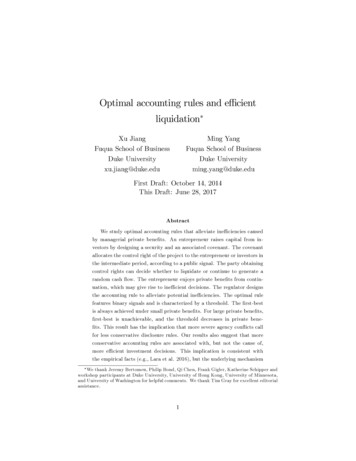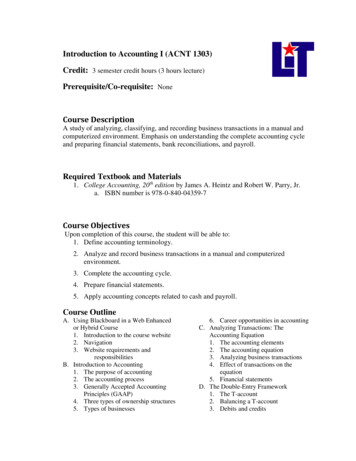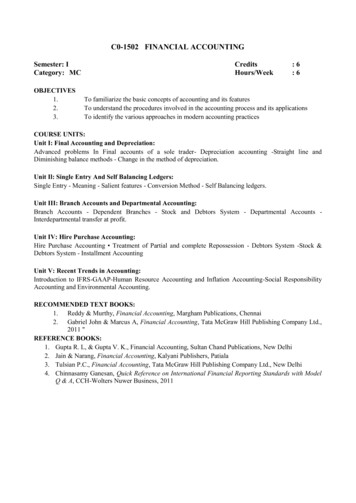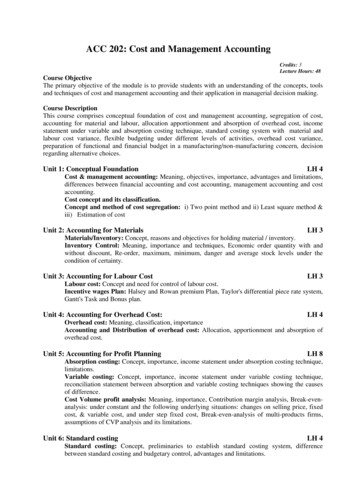
Transcription
Optimal accounting rules and e cientliquidationMing YangFuqua School of BusinessDuke Universityming.yang@duke.eduXu JiangFuqua School of BusinessDuke Universityxu.jiang@duke.eduFirst Draft: October 14, 2014This Draft: June 28, 2017AbstractWe study optimal accounting rules that alleviate ine ciencies causedby managerial private bene ts. An entrepreneur raises capital from investors by designing a security and an associated covenant. The covenantallocates the control right of the project to the entrepreneur or investors inthe intermediate period, according to a public signal. The party obtainingcontrol rights can decide whether to liquidate or continue to generate arandom cash ‡ow. The entrepreneur enjoys private bene ts from continuation, which may give rise to ine cient decisions. The regulator designsthe accounting rule to alleviate potential ine ciencies. The optimal rulefeatures binary signals and is characterized by a threshold. The rst-bestis always achieved under small private bene ts. For large private bene ts, rst-best is unachievable, and the threshold decreases in private bene ts. This result has the implication that more severe agency con‡icts callfor less conservative disclosure rules. Our results also suggest that moreconservative accounting rules are associated with, but not the cause of,more e cient investment decisions. This implication is consistent withthe empirical facts (e.g., Lara et al. 2016), but the underlying mechanismWe thank Jeremy Bertomeu, Philip Bond, Qi Chen, Frank Gigler, Katherine Schipper andworkshop participants at Duke University, University of Hong Kong, University of Minnesota,and University of Washington for helpful comments. We thank Tim Gray for excellent editorialassistance.1
di ers from those o ered in the literature. Finally, our results are robustto various forms of security design, and the contract used in equilibriumis renegotiation-proof.2
1IntroductionWe study the optimal accounting rule in the presence of managerial private bene ts. A nancially constrained entrepreneur1 has exclusive access to a projectand seeks nancing from an outside investor. The project can be terminated inan intermediate period and generates a xed termination value. Otherwise itcontinues to operate and generates a nal cash ‡ow, which is uncertain. Besidesthe potential cash ‡ow bene t, the entrepreneur also enjoys private bene tsfrom the continuation of the project. To nance the project, the entrepreneurissues a security to an outside investor. The security speci es how to split the nal cash ‡ow if the project continues in the intermediate period. It also includes a covenant that speci es the control right of the project regarding thecontinuation decision as well as the way to split the termination value if thatis needed.2 In the intermediate period, an accounting signal of the nal cash‡ow is generated according to an accounting rule and can be used to design thecovenant. As a result, the control right can be allocated contingent on the realization of the accounting signal. For a given accounting rule, the entrepreneurdesigns the security to maximize his expected payo , which consists of both thecash ‡ow bene t and the private bene t. The private bene t gives the entrepreneur an excessive incentive to continue the project, even if the accounting signalsuggests a pessimistic prospect and thus could be detrimental to social welfare.Anticipating the potential distortion, the social planner designs the accountingrule to maximize social welfare. We nd that larger private bene ts call foraccounting rules that generate more informative bad news but less informativegood news, regardless of the security issued. Hence our paper casts doubt onthe opinion that more severe agency problems (in the context of larger privatebene ts) demand more conservative accounting (e.g., Ball 2001).Accounting disclosures are often viewed as an e ective way to alleviateagency problems (e.g., Watts 2003a). As argued by Ball (2001), managerialprivate bene ts are probably the most common source of agency problems.Managers often hesitate to terminate bad projects due to their private bene ts from continuation. For example, managers have a tendency to control moreresources and oversee larger rms, known as “empire building”in the literature.1 Weuse the term “entreprenuer” and “manager” interchangeably.that any security can be viewed as containing a covenant. For example, an equity security can be viewed as containing a covenant that gives all decision rights to the entreprenuerin the intermediate period.2 Note3
Managing rms also gives managers information that could be used to pursuetheir private interests. In addition, holding managerial positions allows themto use rms’resources to pay for perquisites like corporate jets, golf club memberships, and rm-subsidized housing. More broadly speaking, private bene tsrepresent frictions that may result in social loss. In the presence of privatebene ts, accounting disclosure can provide timely and relevant information tomitigate managers’ excessive incentive of continuation. This paper identi esthe most relevant information that should be disclosed and derives the optimalaccounting rule.Our main results are as follows. First, it is socially optimal to choose a binaryaccounting rule. This is because accounting signals are used to make the (binary)termination/continuation decisions. In particular, the binary accounting ruleis threshold based. It generates a good news signal when the nal cash ‡owis above a threshold and a bad news signal when the cash ‡ow is below it.In equilibrium, the project continues if the good news signal is observed andterminated otherwise.Second, the exact value of the (social planner’s) optimal threshold dependson the magnitude of the entrepreneur’s private bene t. From the social planner’s perspective, the rst-best decision rule is to terminate the project whenthe nal cash ‡ow is below the termination value and continue it otherwise.This amounts to setting a threshold equal to the project’s termination value,which is referred to as the socially e cient threshold thereafter. However, theentrepreneur, due to his private bene t, may still want to continue the project,even if the accounting signal suggests a cash ‡ow below the socially e cientthreshold. We nd that, under moderate level of agency problems, the sociallye cient threshold remains optimal, despite the presence of a private bene t.This is because the entrepreneur’s private bene t is dominated by the potential social loss from continuing a project that should have been terminated.As a result, the entrepreneur is willing to forgo his private bene t and obtaincompensation from implementing the rst-best decision rule, given a properlydesigned security. In contrast, when the agency problem is severe, meaning thatthe private bene t exceeds the potential loss from pursuing a bad project, it isimpossible to implement the rst-best decision rule, and the optimal thresholdfalls below the socially e cient threshold.Third, when the rst-best decision rule is not implementable, the optimalthreshold falls as the agency problem becomes more severe. This is because thelarger the private bene t, the more eager the entrepreneur is to continue. This4
calls for a more informative bad news signal to pursuade him to terminate. Tomake the “bad news” signal more informative, the social planner reduces thethreshold.Finally, our results are robust in the sense that the qualitative propertiesof the optimal accounting rule do not depend on the speci c security design.In particular, given any accounting rule, for any security for which the investorbreaks even, the entrepreneur can nd a covenant to maximize his expectedpayo that consists of both the cash ‡ow bene t and the private bene t. Sincethe investor always just breaks even, maximizing the entrepreneur’s expectedpayo amounts to maximizing the sum of social welfare plus his private bene t,regardless of the security design. Anticipating this irrelevance, the social plannercan choose the accounting rule independent of security design. Our resultsare also robust in the sense that the optimal contract (the security and theassociated covenant) is renegotiation-proof.The empirical implications of our ndings are twofold. On one hand, our ndings cast doubt on the conventional wisdom that more severe agency problems call for more conservative accounting. We show that the larger the privatebene t, the lower the threshold. This results in the “good news” signal beingless informative but the “bad news”signal being more informative, corresponding to more aggressive accounting, as established in the literature (e.g., Gigleret al. 2009). On the other hand, our model provides a formal theory to justify the positive association between accounting conservatism and investmente ciency, a result well documented in the empirical literature (e.g. Lara et al.2016). We also show that the positive association does not imply a causal e ectof accounting conservatism on investment e ciency.Our paper makes several contributions to the accounting and nance literatures.3 First, we jointly study the e ect of mandatory disclosure on alleviatingagency problems and security design. To the best of our knowledge, we arethe rst study of this fundamentally important issue that does not impose anyparticular structure on feasible securities and accounting rules. We show thatwhen the key decision is binary, the optimal accounting rule always generatesbinary signals and can be characterized by a threshold, which can be naturallylinked with conservatism. Second, we show that, when the agency problem isserious enough, the more severe the agency problem, the less conservative theoptimal accounting rule should be. This implies that an agency problem in itself3 Pleasesee section 2 for a detailed review of the revelant literature.5
may not necessarily imply a demand for conservative accounting, even thoughmore conservative accounting is associated with higher investment e ciency andhigher social welfare in our model. Finally, we contribute to the burgeoning literature applying the insights from the Bayesian persuasion literature to modelaccounting rules. We study the optimal accounting rule in a classical corporate nance setting with fairly general assumptions.The paper is organized as follows. The next section discusses related literature. Section 3 presents the model, and Section 4 discusses our main results.Section 5 provides comparative statics, and Section 6 discusses how our resultsrelate to accounting conservatism. Section 7 discusses implications, and Section8 concludes. The appendix contains all the proofs.2Related literatureFirst, our paper relates to the literature on Bayesian persuasion and its applications in nance and accounting. In nance, Goldstein and Leitner (2015)study the optimal stress test rule in a Bayesian persuasion setting. They alsoestablish that, when the action is binary (i.e. the creditors choose whether towithdraw their deposit), the optimal stress test rule is binary. They focus ondisclosure for nancial institutions, whereas we focus on disclosure for a general rm. In accounting, the paper that closely relates to ours is by Huang (2016).4Huang (2016) also studies the optimal accounting rules in a similar entrepreneurseeking- nancing setting when the investor can subsequently choose whether toacquire private information after the accounting disclosure. We do not considersubsequent information acquisition. In addition, we allow for arbitrary securityissuance, whereas Huang (2016) assumes that the entrepreneur issues an exogenous fraction of equity to the investor. We show that the optimal accountingrules generate binary signals, whereas binary signal structure is exogenouslyassumed by Huang (2016). Finally, Huang (2016) stipulates that the optimalaccounting rule is chosen by the entrepreneur to maximize the entrepreneur’spayo , whereas here it is chosen by a social planner to maximize the social welfare, making the optimal accounting rule in our setting more representative ofmandatory accounting rules.4 Other examples include Friedman et al. (2016), who study how subsequent voluntarydisclosures a ect mandatory accounting disclosures; Jiang and Yang (2017) that study theoptimal accounting rule in a signalling game and Michaeli (2017) that studies the interplaybetween producing and disseminating information in a nancial reporting setting.6
Recently, Szydlowski (2016) and Trigilia (2016) consider the joint design ofdisclosure policy and security from the entrepreneur’s perspective. Hence theentrepreneur is essentially the sole strategic player, and the disclosure is bestinterpreted as voluntary disclosure. In contrast, in our setting, the accountingrule is chosen by the social planner to alleviate the potential agency problem andis mandatory for the entrepreneur. In addition, Trigilia (2016) studies a reducedform disclosure strategy in which the entrepreneur only chooses a probabilityof fully revealing disclosure (versus no disclosure). Szydlowski (2016) studiesgeneral disclosure rules modelled by Bayesian persuasion and highlights theindeterminacy of optimal securities, which essentially results from the absenceof information asymmetry, as argued in our paper.In our model, covenant design plays a central role in the robustness of theresults to security design. Garleanu and Zwiebel (2009) and Gigler et al. (2009)also study covenant design in di erent settings. However, they focus on debtsecurities, whereas we do not restrict the type of securities issued by the entrepreneur.Our paper relates to the literature exploring what the optimal accountingrule should be in the presence of various types of agency con‡icts. Caskeyand Hughes (2012) nd that, in the presence of an asset-substitution problemand when debt security is issued, the optimal accounting rule should be fairvalue based, subject to conservative adjustment; in Gox and Wagenhofer (2009),the optimal accounting rule is conditionally conservative in the presence of amoral hazard problem and debt security; in Bertomeu and Cheynel (2015), itis asymmetric when there are frictions in credit markets; in Jiang and Yang(2017), it features a lower bound and a su cient statistic in the presence ofasymmetric information and equity security. This paper studies the optimalaccounting rule in the presence of a common agency problem, private bene tsfrom project continuation. The major di erence between this study and most ofthe other studies is that we allow for arbitrary types of securities, and we do notrestrict possible accounting rules a social planner can choose, which increasesthe robustness of our results.Our paper relates to the analytical literature on whether accounting shouldbe more or less conservative. Numerous papers have shown, in various settings,that conservative accounting can be good or bad (e.g. Guay and Verrecchia 2006;Gigler et al. 2009; Gox and Wagenhofer 2009; Caskey and Hughes 2012; Gao2013a; Li 2013; Caskey and Laux 2013; Bertomeu et al. 2014; Armstrong et al.2014; Friedman et al. 2016). We di er from those papers in that we do not model7
accounting conservatism explicitly but interpret whether the optimal accountingrules are conservative following notions developed in previous literature. Notonly do we generalize prior ndings, as we do not impose a particular form ofsecurity, but we nd the counterintuitive result that the more severe the agencyproblem, the less conservative the accounting rules will be.Finally, in a broader sense, our paper relates to the literature on thresholddesign in accounting and nance, as our optimal accounting rule is characterized by a threshold. Examples include papers by Dye (2002), Magee (2006),Mittendorf (2010), Fan and Zhang (2012), Laux and Stocken (2013), and Gao(2014). However, most of the papers in this literature assume the existenceof a threshold and derive properties of the threshold in di erent settings. Incontrast, our threshold is derived endogenously as an component of the optimalaccounting rule.3ModelWe consider a three-date model with three risk-neutral players: a social planner,an entrepreneur, and an investor. Without loss of generality, we assume allplayers’discount factor is equal to one.Project The entrepreneur has exclusive access to a project that requiresinitial investment k 0 to start at date 0. At date 1, the project can eitherbe terminated and generate a termination value M 0 or continue to date 2and generate a random nal cash ‡ow 0. We assume that the three playersshare a common prior P about . We also assume the probability density exists,denoted by p, with supp(p) ;.Accounting rule Before date 0, the social planner designs an accountingrule f that generates a signal x 2 X at date 1, where XR is the set of signalrealizations. In particular, the accounting rule is modelled as an informationstructure f :;!(X), with f ( j ) denoting the probability measure oversignal realizations, conditional on the true state being . We do not impose anyrestriction on the social planner’s choice of f .Timeline and security design At date 0, the entrepreneur is nanciallyconstrained. To nance the project, he needs to raise k from the investor byissuing a security (c; s; MI ). Speci cally, c : X ! fE; Ig is a covenant that allocates the control right of the project at date 1 according to the signal realizationx. The entrepreneur obtains the control right to decide whether to continue or8
terminate the project if c (x) E, and the investor has the control right ifc (x) I. If the project continues to date 2, it generates a cash ‡ow , in whichs ( ) goes to the investor ands ( ) remains with the entrepreneur. If theproject is terminated at date 1, the investor receives MI , and the entrepreneurreceives MMI . The entrepreneur’s security design is subject to the limitedliability constraint. That is, the entrepreneur can only choose s and MI fromS s:;! 0;js ( ) 2 [0; ] for alland [0; M ], respectively.Preferences The social planner’s objective is to maximize social welfare,measured by the expected total cash ‡ow from this project. That is, the socialplanner would prefer to continue the project at date 1 if and only if the expectedvalue of the nal cash ‡ow exceeds the termination value M . The entrepreneur,however, enjoys a private bene t B, in addition to his cash ‡ows ( ), fromcontinuing the project. We assume B 2 [0; M ] to avoid the trivial case that Bis so large that continuation is always the entrepreneur’s favored option. Theinvestor is passive in this game in the sense that she is willing to o er k to nance the project, provided that her expected payo at date 0 exceeds herreservation value v I 0. This reservation value speci es the investor’s requiredrate of expected return, which depends on her bargaining power, outside option,etc.Incentives For any given accounting rule, the entrepreneur designs thesecurity (c; s; MI ), subject to the investor’s participation constraint, in orderto maximize his expected payo , which consists of both the cash ‡ow bene ts ( ) and the private bene t B. Depending on the security design, potentialcon‡icts of interests between the investor and entrepreneur may arise regardingwhether to continue the project at date 1. For example, if E ( s ( )j x) MIand E (s ( )j x) MMI , the entrepreneur would prefer to continue, butthe investor would prefer to terminate. In addition, the private bene t givesthe entrepreneur an extra incentive to continue the project, even if the signalsuggests a pessimistic prospect and thus could con‡ict with the social planner’sobjective. Anticipating the potential distortion, the social planner designs theaccounting rule f to maximize the social welfare.It is obvious that, if the investor’s reservation value v I is too large, thereis no way to nance the project, and the game becomes trivial. We make thefollowing assumption to avoid this issue.9
Assumption 1:E[ ]vI(1)Assumption 1 is a su cient condition to ensure that the ex ante total proceeds from the project are large enough to cover the investor’s reservation value.Given this condition, in principle, the entrepreneur should be able to nd a security design to nance the project while making the investor at least breakeven. We assume that Assumption 1 holds for the rest of the analysis.We next de ne the equilibrium of this game. Let a : X ! f0; 1g denote adecision rule in date 1, where a (x) 1 means that the project continues to date2 upon signal realization x and a (x) 0 means termination.Equilibrium An equilibrium is a set of rules f(s; c; MI ) ; f; ag such thati) a (x) 1 if c (x) I andEf [ s ( )j x] MI ,or if c (x) E andEf [s ( )j x] B MMI ,where Ef [ ] denotes the expectation operator under accounting rule f ;ii) a (x) 0 if c (x) I andEf [ s ( )j x]MI ,or if c (x) E andEf [s ( )j x] BMMI ;iii) given the accounting rule f , f(s; c; MI ) ; agmaximizesEf [a (x)Ef (s ( ))jx) B (1a (x)) (MMI )]subject to s 2 S, MI 2 [0; M ], i), ii) andvIf (s; MI ; a)vI ,wherevIf (s; MI ; a) Ef [a (x) Ef (s ( ) jx) (110a (x)) MI ](2)
is the investor’s expected payo given s; MI and the decision rule a;iv) the accounting rule f maximizesEf [a (x) Ef ( jx) (1a (x)) M ](3)subject to i), ii), and iii).In this de nition, condition i) requires that the project continues to date 2if the party who obtains the control right prefers continuation to termination.Similarly, condition ii) states that the project terminates if the party who obtainsthe control right prefers termination to continuation. Condition iii) states thatthe entrepreneur designs the security to maximize his expected payo , whichis given by (2), such that the investor at least breaks even. Condition iv)states that, anticipating the entrepreneur’s response in security design, the socialplanner proposes the accounting rule to maximize the social welfare as given by(3).4Analysis and ResultsWe solve the equilibrium through backward induction. We rst solve for theentrepreneur’s optimal response to any given accounting rule chosen by theregulator. We then solve for the social planner’s optimal accounting rule giventhe entrepreneur’s optimal response.For any accounting rule f , let af : X ! f0; 1g be de ned byaf (x) 1 if Ef ( jx) B M.0 otherwise(4)Then af is the decision rule that maximizes the total surplus from the entrepreneur’s perspective (i.e., including his private bene t B) under the accountingrule f . Let SM f denote the set of all pairs of (s; MI ) that make the investorjust break even when af is implemented. That is,noSM f (s; MI ) s 2 S; MI 2 [0; M ] ; vIf (s; MI ; af ) v I .Note that SM f is non-empty. This is because vIf (s; 0; af ) 011v I if s ( ) 0
for all , andvIf (s; M fEB; af )max Ef ( jx) ; MBE[ ]vI ,if s ( ) for all . Since vIf (s; MI ; af ) is continuous in s and MI , there mustexist a pair (s; MI ) such that vIf (s; MI ; af ) v I . If the entrepreneur choosesa pair (s; MI ) 2 SM f and implements the decision rule af , he simultaneouslymaximizes the total surplus and minimizes the investor’s expected payo without violating the participation constraint and thus obtains the highest possibleexpected payo . We show that, for any pair (s; MI ) 2 SM f , the entrepreneurcan always nd a covenant to achieve this goal.Proposition 1 For any given accounting rule f , (i) for any pair (s; MI ) 2SM f , there exists a covenant c such that (s; MI ; c) implements af ; ii) it isoptimal for the entrepreneur to choose (s; MI ) 2 SM f together with the corre-sponding covenant c to implement af .From this proposition, we see that the entrepreneur’s optimal security designis not unique. Any pair (s; MI ) 2 SM f together with its corresponding covenantc is optimal. This multiplicity partially results from the signal x being publicand the two parties always sharing the same information. Thus the two partiesuse the same belief to calculate their expected payo s and do not care aboutthe state-contingency details of security design. This multiplicity also partiallystems from the ‡exibility in covenant design, as shown in the proof, which helpsus circumvent the con‡ict of interests of the two parties. This result di ers frommost security design models, which derive the optimal securities from variousforms of information asymmetry. On one hand, this multiplicity weakens thepredictive power of the model on security design. On the other hand, it greatlysimpli es our analysis of the accounting rule design problem and makes theresults robust to the variation of security designs.Now we are ready to solve for the social planner’s optimal accounting rule.According to Proposition 1, for any accounting rule f , the entrepreneur is always able and willing to implement decision rule af . Then the social planner’s12
problem becomesmax Ef [af (x) Ef ( jx) (1faf (x)) M ] .(5)Following the “posterior approach”of Kamenica and Genzkow (2011), choosingan accounting rule f :posterior beliefs of;!(X) amounts to choosing a distribution ofindexed by x 2 X. In particular, each posterior beliefwill induce an action in the intermediate period. Since the decisions are binary,as a standard result in the Bayesian persuasion literature, it is su cient toconsider binary signal realizations, with one inducing termination and the otherinducing continuation. Without loss of generality, we let X f0; 1g, with x 0referring to termination and x 1 to continuation. Then the accounting ruleis characterized by a function f ( ) Pr(x 1j ).5 The social planner thenchooses this function to maximize the social welfare (5), taking into account theentrepreneur’s response characterized in Proposition 1. The problem reduces toa standard optimization problem, and the results are summarized in Proposition2.Proposition 2 The optimal accounting rule f is characterized by a thresholdb 2 (M B; M ], such that1 if0 iff ( ) bb.In particular, if B E(MjM ), b M . If B E(Mb 2 (M B; M ) and is uniquely pinned down byE[ jb] MjM ), thenB .Moreover, the optimal decision rule is a (x) x, and the corresponding covenantc can be determined according to (s; MI ) 2 SM f , as argued in the proof ofProposition 1.To understand the result, note that, from the social planner’s perspective,it is always optimal to continue when M and terminate when M ,corresponding to a threshold b M . Thus, whenever b M is feasible, thesocial planner will want to choose it. When B is su ciently small, the distortion5 Notethat Pr(x 0j ) 1Pr(x 1j ).13
induced by the excessive desire for the entrepreneur to continue is not severe.The reason is that it is always feasible to ask the entrepreneur to terminatewhen it should be terminated and compensate the entrepreneur for the lostprivate bene t. When B is not large, such compensation is not too large, sothe investor is still able to get v I . This implies that b M is feasible and willbe chosen by the social planner, i.e. rst-best is retained. Speci cally, notethat the optimal accounting rule generates two signals, 1 or 0, or, equivalently,high and low. When accounting signal is high, both parties infer thatM.The optimal action is to terminate, consistent with the socially optimal action.When accounting signal is low, both parties infer that M . The optimalaction is then to continue, again consistent with the socially optimal action.6When the private bene t is su ciently large, rst-best is not achievable, asthe entrepreneur has the incentive to continue even whenis su ciently low.Giving the entrepreneur a higher payo in case of termination will not work,as B is so large that giving the entrepreneur a higher payo to prevent himfrom continuing will result in investor’s payo being lower than v I . As a result,the social planner will tolerate continuation even when M , implying thatb M .7 From Proposition 1, the entrepreneur will choose to terminate onlywhen E ( jx) B M , i.e. when the expectation ofis so low that even whenaccounting for the private bene t, it is not worth continuing. The insights fromthe Bayesian persuasion literature will then suggest that the social planner willchoose the distribution of posteriors such that the entrepreneur is just indi erent between continuation and termination upon learning bad news. Speci cally,if the social planner sets b to be higher, the posterior upon x 0 is more opti-mistic, and the entrepreneur will want to continue even when x 0, resulting inlower social welfare. If the social planner sets b to be lower, the posterior uponx 1 will be more pessimistic. Since the entrepreneur will still continue whenobserving x 1, social welfare will also be lower, because more projects thatshould be terminated are continued under the more pessimistic posterior. Thisb B M,implies that b will be set such that E ( jx 0) B E j6 Note that any accounting rule that generates a distribution of posteriors that is ner inthe Blackwell sense than the optimal accounting rule characterized by b M , including fulldisclosure, will also be optimal. Our solution is therefore the coarsest accounting rule. It canbe justi ed on the ground that ner rules are more costly and any rules that are coarser andstill optimal is more likely to be chosen. Alternatively, as argued by Huang (2016), one canassume a cost of installing an accounting system that increases with the informativeness ofthe accounting signals. Our optimal accounting rule will be the limiting result when the costgoes to zero.7 This implies that full disclosure is not optimal as noted in the previous footnote, fulldisclosure is equivalent to b M .14
or, equivalently, E[ jb] Mis low, both parties infer thatB. In this case, when the accounting signalb M . Thus, termination generates no deci-sion errors.
Optimal accounting rules and e cient liquidation Xu Jiang Fuqua School of Business Duke University xu.jiang@duke.edu Ming Yang Fuqua School of Business Duke University ming.yang@duke.edu First Draft: October 14, 2014 This Draft: June 28, 2017 Abstract We study optimal accounting rules that alleviate ine ciencies caused by managerial private .










